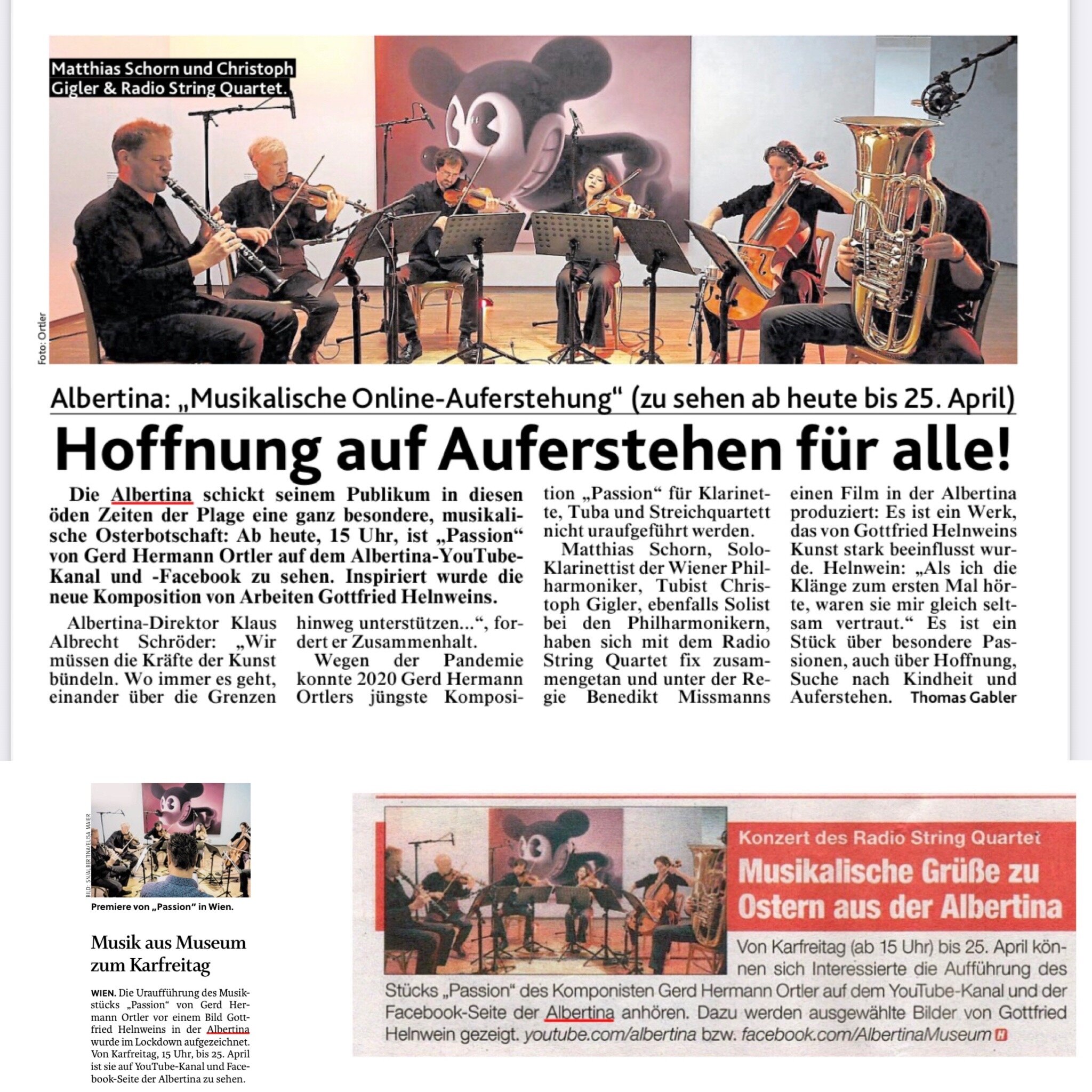Passion
for Clarinet, Tuba and String Quartet (2020)
Composed by Gerd Hermann Ortler to Pictures by Gottfried Helnwein
Clarinet - Matthias Schorn
Tuba - Christoph Gigler
radio.string.quartet:
Violin I - Bernie Mallinger
Violin II - Igmar Jenner
Viola - Cynthia Liao
Cello - Sophie Abraham
Audio Production - Christoph Gigler, Matthias Schorn, Gerd Hermann Ortler, Veronika Schicho and Kristopher R. Campbell
Director / Camera / Editor - Benedikt Missmann
Camera / Light - Ferdinand Koestler
Light Assistant - Stella-Joya Puelacher
Produced by Gerd Hermann Ortler
Co-Produced by Christoph Gigler, Matthias Schorn and Veronika Schicho
© Copyright of Music Gerd Hermann Ortler
PASSION for Clarinet, Tuba and String Quartet (2020)
Composition Commissioned by PalmKlang Festival Oberalm
© Copyright of Art Work Gottfried Helnwein
The Man Who Laughs
I Walk Alone
Epiphany III (Presentation)
Murmur Of The Innocents 5
Untitled (Birdman)
The Disasters Of War 4
The Disasters Of War 28
Payton Blue 1
Pink Mouse 2
Epiphany 1 (The Adoration of the Magi 3)
Estimated Duration: 42 Min.
Due to the COVID-19 crisis the world premiere of PASSION could not take place at the PalmKlang Festival. In these challenging times we were inspired by a main message of PASSION: The hope for resurrection. Therefore we joined forces with other art forms and developed a new concept for the premiere; we exchanged the stage for a museum and the audience for a camera. On the 3rd and 4th of July 2020 we spent the night at the Albertina Museum in Vienna. Surrounded by and inspired by the art of Gottfried Helnwein, we brought PASSION to life. The result is this film, a resurrection of our artistic beliefs and hopes.
— Gerd Hermann Ortler, February 2021
“Die atemberaubende Komposition Gerd Hermann Ortlers hat mich zutiefst berührt und erschüttert. Als ich die Klänge zum ersten Mal hörte, waren sie mir doch seltsam vertraut. Es gehört zu den ganz besonderen Augenblicken in der Kunst, wenn sich ein Künstler mit seiner Arbeit auf das Werk eines andern Künstlers bezieht und sich durch eine eigene, neue Kreation mit ihm verbindet. Mein Dank gilt auch der ALBERTINA, die bewiesen hat, dass das Museum wirklich ein Hort der Musen sein kann”
Press



WORK DESCRIPTION (English)
With my composition, I tell the story of the Passion without any spoken or sung words. By focusing only on the instrumental aspects an open level was achieved in which musical elements such as timbre, rhythm, motif, and dynamics become the driving forces. The soloistic emergence of the clarinet and tuba reinforces this and establishes a counterpoint with the collective of the string quartet.
The musical plot is extended visually because I have placed it in context with selected pictures by Gottfried Helnwein. So together with the music, the images dissolve the Passion from its traditional framework and take on a metaphor for the inner child and its path of suffering in all of us.
The child that we all carry inside of us but which is being cast out systematically, turning us into “useful people” for societal purposes and which we now painfully yearn for a lifetime. This child is our true nature, our perfect being, perhaps even the divine in us.
I also see this in the equally disturbing and inspiring art by Gottfried Helnwein, who places the harmed child at center of his works but which nevertheless radiates an inner invincibility.
Making sacrifices, suffering and finding salvation in dying of ones own conviction are the central aspects of the Passion. Yet above all of that stands hope, probably the greatest strength of human kind: Contrary to all reason, it rises above impossibility as an existential desire to grow beyond oneself. The hope of rediscovering the inner child within us which is paradise, makes our existence as human beings bearable.
— Gerd Hermann Ortler, March 2020
WORK DESCRIPTION (German)
Ich erzähle mit meiner Komposition die Passionsgeschichte ohne das gesprochene und gesungene Wort. Durch die Konzentration auf das Instrumentale wird eine offene Ebene erreicht, in der musikalische Elemente wie Klangfarbe, Rhythmus, Motivik und Dynamik die treibenden Kräfte sind. Das solistische Hervortreten von Klarinette und Tuba verstärkt dies und bildet einen Kontrapunkt zum Verband des Streichquartetts.
Die musikalische Handlung wird zudem visuell erweitert, denn ich stelle sie in den Kontext ausgewählter Bilder von Gottfried Helnwein. Diese Bilder lösen im Zusammenspiel mit der Musik die Passion aus ihrem traditionellen Rahmen und lassen sie zur Metapher für den Leidensweg des Kindes in uns werden.
Des Kindes, das wir alle in uns tragen, das aber systematisch ausgetrieben wird, um aus uns „brauchbare Menschen“ für die Gesellschaft zu machen und nach dem wir uns nun schmerzlich ein Leben lang zurücksehnen. Dieses Kind ist unsere eigentliche Natur, unser vollkommenes Wesen, vielleicht sogar das Göttliche in uns.
Dies sehe ich auch in der gleichsam inspirierenden wie aufwühlenden Kunst von Gottfried Helnwein, der das versehrte Kind ins Zentrum seiner Werke rückt, welches aber trotzdem eine innere Unbesiegbarkeit ausstrahlt.
Für seine Überzeugung Opfer zu bringen, zu leiden und im dafür Sterben Erlösung zu finden, sind zentrale Aspekte der Passion. Doch darüber steht die Hoffnung, die wohl stärkste Kraft des Menschen: entgegen aller Vernunft erhebt sie sich über die Aussichtslosigkeit als existentieller Antrieb, über sich hinauszuwachsen. Denn die Hoffnung, das verlorene Kind und damit das Paradies in uns wieder zu finden, macht uns das Menschsein erträglich.
— Gerd Hermann Ortler, März 2020